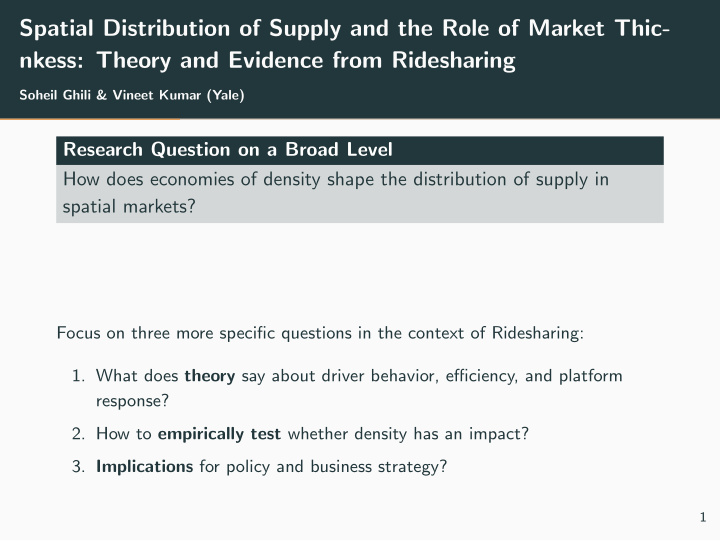



Spatial Distribution of Supply and the Role of Market Thic- nkess: Theory and Evidence from Ridesharing Soheil Ghili & Vineet Kumar (Yale) Research Question on a Broad Level How does economies of density shape the distribution of supply in spatial markets? Focus on three more specific questions in the context of Ridesharing: 1. What does theory say about driver behavior, efficiency, and platform response? 2. How to empirically test whether density has an impact? 3. Implications for policy and business strategy? 1
Quick Answers: Theory • Equilibrium distribution of drivers skewed towards regions with higher demand density. • ⇒ demand more likely to go unfulfilled in less dense regions. • Platform desires some skew but not as much as arises in equilibrium. • Platforms should encourage a more even distribution through using wages and prices as levers. • All of the above are more pronounced for smaller platforms. 2
Quick Answers: Empirically Testing the Theory Objective: Test the implications of the model • Demand more likely to go unfulfiled in less dense regions • More pronounced for smaller platforms. Challenge: Unfulfilled demand is unobserved. • cannot tell whether percent fulfillment in region i is more than i ′ . Solution: For each trip there is a “trip back” • If riders use Lyft to exit region i consistently less than they do to enter it ⇒ Lyft’s supply is skewed from i . • Especially if the same is not true of Uber. Findings: supply skewed towards denser areas: • Skew is more pronounced for smaller platforms. • Skew is much more pronounced for taxi (compared to rideshare) 3
Quick Answers: Implications for Policy and Business Strategy Business Strategy: • Platforms should incentivize drivers to operate in less dense areas through higher wages • but avoid passing the full extra cost to passengers. Policy • Breaking up or downsizing rideshare platforms can disproportionately hurt outer areas. • Our analysis: minimum required size is 120K rides/day for NYC. 4
Recommend
More recommend